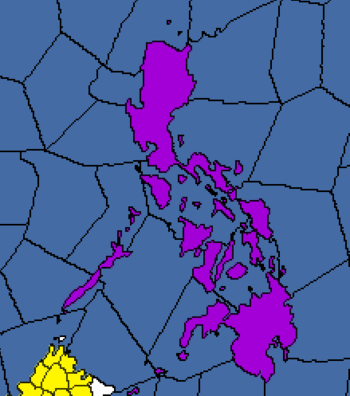Las Islas del Poniente
The Commonwealth of the West Indies La Maharlikano Comunidad de la Islas del Poniente | |
|---|---|
| Motto: El destino marcha como cualquier hombre Destiny marches like any man | |
| Anthem: Maharlikan Flight | |
 | |
| Capital | Vigan City |
| Largest City | Manila |
| Recognised regional languages | Tagalog, Waray, Bicolano, Ilocano, Pangasinense, Bisaya, Moro, Pampangeno |
| Ethnic groups (1820) | Malay (98.7%) Chinese (0.6%) Mestizo (0.2%) Negrito (0.3%) Caucasian (0.2%) Negro (0.01%) |
| Demonym(s) | Filipino, Ponienteian |
| Government | Devolved Constitutional Parliamentary Monarchy |
• Supreme Chief | Teodoro Lucero y Maal |
• Triumvirate | Jose Villanueva Rajah Matanda Tarik Salah-al Din |
| Legislature | Rajahanate Council |
| Independence from the Spanish Empire | |
• Declaration of Independence | January 24, 1744 |
• Antipolo Articles of Confederation | December 19, 1763 |
• Spanish Withdrawal | August 13, 1790 |
• Constitution | June 12, 1794 |
| Population | |
• 1820 estimate | 2, 400, 000 |
| Currency | Peso (₱) |
| Time zone | UTC+8 (Manila Time) |
| Date format | mm-dd-yyyy |
Etymology
During his expeditions in 1542, Spanish explorer Ruy López de Villalobos named the islands of Leyte and Samar "Felipinas" in honor of Philip II of Spain. Eventually, the name Las Islas Filipinas would be used to cover the archipelago's Spanish possessions. The demonym of Philippine is an anglicized translation of the Spanish name.
During the Ponienteian Revolution, the Antipolo Pact proclaimed the establishment of the La Maharlikano de las islas del Poniente or the Commonwealth of the West Indies. A Maharlika is a Tagalog word which refers to the feudal warrior class of the Tagalog Societies in the Luzon island.
History
Colonial rule (1565-1790)
Colonization of the Philippine Isles began when the Spanish explorer Miguel Lopez de Legazpi arrived from Mexico in 1565. In 1571, Spanish Manila became the capital of the Spanish East Indies, encompassing all Spanish territories in Asia and the Pacific. As the native population are often divided by the many different cultures, ethnicities, and religions throughout the scattered islands, the spanish were able to successfully subjugate the the local states with the use of divide and conquer strategies, bringing what is now the Philippine Commonwealth into a single and unified administration. Catholic missionaries were able to convert the masses easily by consolidating the small barangay settlements into towns. From 1565 to 1790, the Philippines was governed as part of the Mexico-based Viceroyalty of New Spain until the Spanish Withdrew from the islands. Manila was the western hub of a trans-Pacific trade route. Manila galleons were mostly constructed in Bicol and Cavite.
The colony received has endured multiple rebellions from the natives who are disgruntled by the mistreatment that are given to them, as well as constant raids and skirmishes from Bornean, Chinese, and Japanese pirates; not to mention threats of engagement from local Portuguese, Dutch, and British forces.


